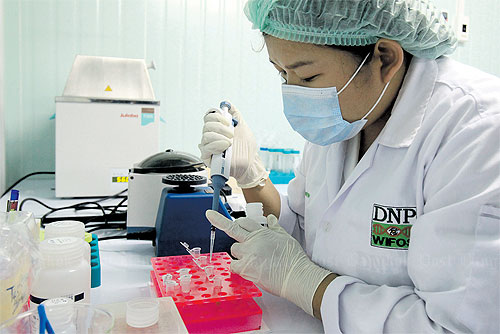As organised wildlife smuggling syndicates adopt advanced tactics to evade police, authorities say the latest forensic technology has helped put officers back on the front foot.

ANIMAL INSTINCTS: A forensic scientist prepares samples for DNA testing at the Wildlife Forensic Science Unit.
''It's often that we get only slices of flesh from dead animals, carcasses, or only blood stains,'' Dr Kanita Ouitavon, a director of the National Parks, Wildlife and Plant Conservation Department's Wildlife Forensic Science Unit, says. Without forensic testing, it would be impossible for authorities to determine which species these samples came from, making convictions against smugglers difficult.
''But if we can prove that the animals are protected species, then justice will be achieved,'' she says.
From a small lab inside the Parks Department compound, Dr Kanita leads a team of about 10 young forensic scientists who examine animal samples in a bid to fight poaching.
The lab has been operating for just two years. Former Parks Department chief Damrong Phidech initiated the operation with the aim of creating a DNA testing lab for herds of domestic elephants.
Since then, the lab's mission has evolved, expanding its scope to supporting police investigations into illegal wildlife smuggling.

TRACE ELEMENT: A DNA sample.
It is the first unit of its kind. In the past, police had to send animal parts to university labs for testing. But those running the labs had no legal obligation to testify about results in court.
Officers can rely on Dr Kanita and her team to give evidence, dramatically increasing the chances of securing a conviction.
As those in the illegal wildlife trade employ increasingly sophisticated smuggling techniques _ particularly for African elephant tusks and rhinoceros horns _ the lab is working to disrupt their operations.
In recent years, wildlife activists have stepped up their campaign to end Thailand's ivory trade, which they blame for the mass slaughter of African elephants.
Tusks are shipped illegally to many countries, especially in Asia, and Thailand is accused of being a major hub for ivory smuggling.
Thailand adheres to Cites (Convention on International Trade in Endangered Species of Wild Fauna and Flora) regulations on the sale of ivory internationally, but still allows the trade of domestic ivory.
Activists claim that this provides a loophole for African ivory to be shipped in and mixed with domestic ivory.
Recently, 20 elephant tusks seized in Chumphon province were sent to Dr Kanita's lab. Police allege the ivory was smuggled with the help of uniformed officials.
The lab's mission now is to prove whether the tusks came from Africa. If they did, that evidence alone would be enough to prosecute the suspects.
Dr Kanita is modestly optimistic about the role her lab is playing in ending the illegal wildlife trade.
She admits that wildlife forensic science may not help crack the criminal gangs operating the smuggling rings, but says the lab's results can at least help officials keep up with what techniques criminals are employing.
''As the gangs grow stronger, those chasing them must also improve to keep up,'' she said.
In the future, Dr Kanita hopes the lab can take a more proactive role in the fight against smuggling. She would like to see a team established that collects fresh evidence from crime scenes rather than just pieces of animals, and maybe also collect DNA evidence from smugglers themselves. ''The DNA carries the truth and it can help link us to the culprits,'' Dr Kanita said.